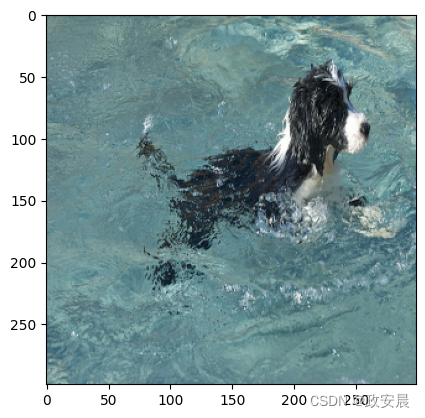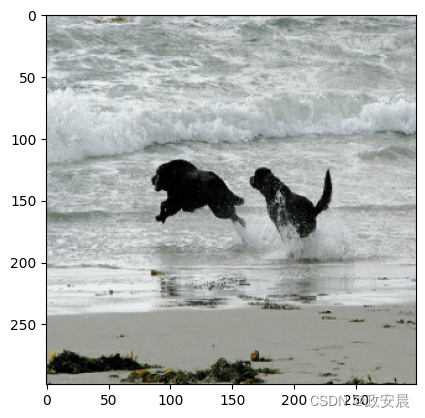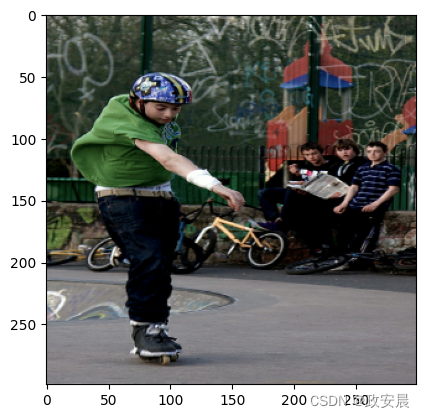本文主要是介绍政安晨:【Keras机器学习示例演绎】(十八)—— 图像字幕,希望对大家解决编程问题提供一定的参考价值,需要的开发者们随着小编来一起学习吧!
目录
设置
下载数据集
准备数据
将文本数据向量化
构建用于训练的tf.data.Dataset管道
构建模型
模型训练
检查样本预测结果
政安晨的个人主页:政安晨
欢迎 👍点赞✍评论⭐收藏
收录专栏: TensorFlow与Keras机器学习实战
希望政安晨的博客能够对您有所裨益,如有不足之处,欢迎在评论区提出指正!
本文目标:使用 CNN 和 Transformer 实现图像字幕模型。
设置
import osos.environ["KERAS_BACKEND"] = "tensorflow"import re
import numpy as np
import matplotlib.pyplot as pltimport tensorflow as tf
import keras
from keras import layers
from keras.applications import efficientnet
from keras.layers import TextVectorizationkeras.utils.set_random_seed(111)下载数据集
本文将使用 Flickr8K 数据集。该数据集包含 8000 多张图片,每张图片都配以五个不同的标题。
!wget -q https://github.com/jbrownlee/Datasets/releases/download/Flickr8k/Flickr8k_Dataset.zip
!wget -q https://github.com/jbrownlee/Datasets/releases/download/Flickr8k/Flickr8k_text.zip
!unzip -qq Flickr8k_Dataset.zip
!unzip -qq Flickr8k_text.zip
!rm Flickr8k_Dataset.zip Flickr8k_text.zip# Path to the images
IMAGES_PATH = "Flicker8k_Dataset"# Desired image dimensions
IMAGE_SIZE = (299, 299)# Vocabulary size
VOCAB_SIZE = 10000# Fixed length allowed for any sequence
SEQ_LENGTH = 25# Dimension for the image embeddings and token embeddings
EMBED_DIM = 512# Per-layer units in the feed-forward network
FF_DIM = 512# Other training parameters
BATCH_SIZE = 64
EPOCHS = 30
AUTOTUNE = tf.data.AUTOTUNE准备数据
def load_captions_data(filename):"""Loads captions (text) data and maps them to corresponding images.Args:filename: Path to the text file containing caption data.Returns:caption_mapping: Dictionary mapping image names and the corresponding captionstext_data: List containing all the available captions"""with open(filename) as caption_file:caption_data = caption_file.readlines()caption_mapping = {}text_data = []images_to_skip = set()for line in caption_data:line = line.rstrip("\n")# Image name and captions are separated using a tabimg_name, caption = line.split("\t")# Each image is repeated five times for the five different captions.# Each image name has a suffix `#(caption_number)`img_name = img_name.split("#")[0]img_name = os.path.join(IMAGES_PATH, img_name.strip())# We will remove caption that are either too short to too longtokens = caption.strip().split()if len(tokens) < 5 or len(tokens) > SEQ_LENGTH:images_to_skip.add(img_name)continueif img_name.endswith("jpg") and img_name not in images_to_skip:# We will add a start and an end token to each captioncaption = "<start> " + caption.strip() + " <end>"text_data.append(caption)if img_name in caption_mapping:caption_mapping[img_name].append(caption)else:caption_mapping[img_name] = [caption]for img_name in images_to_skip:if img_name in caption_mapping:del caption_mapping[img_name]return caption_mapping, text_datadef train_val_split(caption_data, train_size=0.8, shuffle=True):"""Split the captioning dataset into train and validation sets.Args:caption_data (dict): Dictionary containing the mapped caption datatrain_size (float): Fraction of all the full dataset to use as training datashuffle (bool): Whether to shuffle the dataset before splittingReturns:Traning and validation datasets as two separated dicts"""# 1. Get the list of all image namesall_images = list(caption_data.keys())# 2. Shuffle if necessaryif shuffle:np.random.shuffle(all_images)# 3. Split into training and validation setstrain_size = int(len(caption_data) * train_size)training_data = {img_name: caption_data[img_name] for img_name in all_images[:train_size]}validation_data = {img_name: caption_data[img_name] for img_name in all_images[train_size:]}# 4. Return the splitsreturn training_data, validation_data# Load the dataset
captions_mapping, text_data = load_captions_data("Flickr8k.token.txt")# Split the dataset into training and validation sets
train_data, valid_data = train_val_split(captions_mapping)
print("Number of training samples: ", len(train_data))
print("Number of validation samples: ", len(valid_data))演绎展示:
Number of training samples: 6114
Number of validation samples: 1529将文本数据向量化
我们将使用TextVectorization层来将文本数据向量化,也就是将原始字符串转换为整数序列,其中每个整数表示词汇表中一个单词的索引。
我们将使用自定义的字符串标准化方案(去除标点符号,除了<和>)和默认的分割方案(根据空白字符进行分割)。
def custom_standardization(input_string):lowercase = tf.strings.lower(input_string)return tf.strings.regex_replace(lowercase, "[%s]" % re.escape(strip_chars), "")strip_chars = "!\"#$%&'()*+,-./:;<=>?@[\]^_`{|}~"
strip_chars = strip_chars.replace("<", "")
strip_chars = strip_chars.replace(">", "")vectorization = TextVectorization(max_tokens=VOCAB_SIZE,output_mode="int",output_sequence_length=SEQ_LENGTH,standardize=custom_standardization,
)
vectorization.adapt(text_data)# Data augmentation for image data
image_augmentation = keras.Sequential([layers.RandomFlip("horizontal"),layers.RandomRotation(0.2),layers.RandomContrast(0.3),]
)构建用于训练的tf.data.Dataset管道
我们将使用tf.data.Dataset对象生成图像和对应标题的配对。
这个管道包括两个步骤:
1. 从磁盘读取图像
2. 对图像对应的五个标题进行分词处理
def decode_and_resize(img_path):img = tf.io.read_file(img_path)img = tf.image.decode_jpeg(img, channels=3)img = tf.image.resize(img, IMAGE_SIZE)img = tf.image.convert_image_dtype(img, tf.float32)return imgdef process_input(img_path, captions):return decode_and_resize(img_path), vectorization(captions)def make_dataset(images, captions):dataset = tf.data.Dataset.from_tensor_slices((images, captions))dataset = dataset.shuffle(BATCH_SIZE * 8)dataset = dataset.map(process_input, num_parallel_calls=AUTOTUNE)dataset = dataset.batch(BATCH_SIZE).prefetch(AUTOTUNE)return dataset# Pass the list of images and the list of corresponding captions
train_dataset = make_dataset(list(train_data.keys()), list(train_data.values()))valid_dataset = make_dataset(list(valid_data.keys()), list(valid_data.values()))构建模型
我们的图像描述架构由三个模型组成:
1. CNN:用于提取图像特征
2. TransformerEncoder:提取的图像特征随后传递给基于Transformer的编码器,生成输入的新表示
3. TransformerDecoder:该模型使用编码器输出和文本数据(序列)作为输入,试图学习生成描述
def get_cnn_model():base_model = efficientnet.EfficientNetB0(input_shape=(*IMAGE_SIZE, 3),include_top=False,weights="imagenet",)# We freeze our feature extractorbase_model.trainable = Falsebase_model_out = base_model.outputbase_model_out = layers.Reshape((-1, base_model_out.shape[-1]))(base_model_out)cnn_model = keras.models.Model(base_model.input, base_model_out)return cnn_modelclass TransformerEncoderBlock(layers.Layer):def __init__(self, embed_dim, dense_dim, num_heads, **kwargs):super().__init__(**kwargs)self.embed_dim = embed_dimself.dense_dim = dense_dimself.num_heads = num_headsself.attention_1 = layers.MultiHeadAttention(num_heads=num_heads, key_dim=embed_dim, dropout=0.0)self.layernorm_1 = layers.LayerNormalization()self.layernorm_2 = layers.LayerNormalization()self.dense_1 = layers.Dense(embed_dim, activation="relu")def call(self, inputs, training, mask=None):inputs = self.layernorm_1(inputs)inputs = self.dense_1(inputs)attention_output_1 = self.attention_1(query=inputs,value=inputs,key=inputs,attention_mask=None,training=training,)out_1 = self.layernorm_2(inputs + attention_output_1)return out_1class PositionalEmbedding(layers.Layer):def __init__(self, sequence_length, vocab_size, embed_dim, **kwargs):super().__init__(**kwargs)self.token_embeddings = layers.Embedding(input_dim=vocab_size, output_dim=embed_dim)self.position_embeddings = layers.Embedding(input_dim=sequence_length, output_dim=embed_dim)self.sequence_length = sequence_lengthself.vocab_size = vocab_sizeself.embed_dim = embed_dimself.embed_scale = tf.math.sqrt(tf.cast(embed_dim, tf.float32))def call(self, inputs):length = tf.shape(inputs)[-1]positions = tf.range(start=0, limit=length, delta=1)embedded_tokens = self.token_embeddings(inputs)embedded_tokens = embedded_tokens * self.embed_scaleembedded_positions = self.position_embeddings(positions)return embedded_tokens + embedded_positionsdef compute_mask(self, inputs, mask=None):return tf.math.not_equal(inputs, 0)class TransformerDecoderBlock(layers.Layer):def __init__(self, embed_dim, ff_dim, num_heads, **kwargs):super().__init__(**kwargs)self.embed_dim = embed_dimself.ff_dim = ff_dimself.num_heads = num_headsself.attention_1 = layers.MultiHeadAttention(num_heads=num_heads, key_dim=embed_dim, dropout=0.1)self.attention_2 = layers.MultiHeadAttention(num_heads=num_heads, key_dim=embed_dim, dropout=0.1)self.ffn_layer_1 = layers.Dense(ff_dim, activation="relu")self.ffn_layer_2 = layers.Dense(embed_dim)self.layernorm_1 = layers.LayerNormalization()self.layernorm_2 = layers.LayerNormalization()self.layernorm_3 = layers.LayerNormalization()self.embedding = PositionalEmbedding(embed_dim=EMBED_DIM,sequence_length=SEQ_LENGTH,vocab_size=VOCAB_SIZE,)self.out = layers.Dense(VOCAB_SIZE, activation="softmax")self.dropout_1 = layers.Dropout(0.3)self.dropout_2 = layers.Dropout(0.5)self.supports_masking = Truedef call(self, inputs, encoder_outputs, training, mask=None):inputs = self.embedding(inputs)causal_mask = self.get_causal_attention_mask(inputs)if mask is not None:padding_mask = tf.cast(mask[:, :, tf.newaxis], dtype=tf.int32)combined_mask = tf.cast(mask[:, tf.newaxis, :], dtype=tf.int32)combined_mask = tf.minimum(combined_mask, causal_mask)attention_output_1 = self.attention_1(query=inputs,value=inputs,key=inputs,attention_mask=combined_mask,training=training,)out_1 = self.layernorm_1(inputs + attention_output_1)attention_output_2 = self.attention_2(query=out_1,value=encoder_outputs,key=encoder_outputs,attention_mask=padding_mask,training=training,)out_2 = self.layernorm_2(out_1 + attention_output_2)ffn_out = self.ffn_layer_1(out_2)ffn_out = self.dropout_1(ffn_out, training=training)ffn_out = self.ffn_layer_2(ffn_out)ffn_out = self.layernorm_3(ffn_out + out_2, training=training)ffn_out = self.dropout_2(ffn_out, training=training)preds = self.out(ffn_out)return predsdef get_causal_attention_mask(self, inputs):input_shape = tf.shape(inputs)batch_size, sequence_length = input_shape[0], input_shape[1]i = tf.range(sequence_length)[:, tf.newaxis]j = tf.range(sequence_length)mask = tf.cast(i >= j, dtype="int32")mask = tf.reshape(mask, (1, input_shape[1], input_shape[1]))mult = tf.concat([tf.expand_dims(batch_size, -1),tf.constant([1, 1], dtype=tf.int32),],axis=0,)return tf.tile(mask, mult)class ImageCaptioningModel(keras.Model):def __init__(self,cnn_model,encoder,decoder,num_captions_per_image=5,image_aug=None,):super().__init__()self.cnn_model = cnn_modelself.encoder = encoderself.decoder = decoderself.loss_tracker = keras.metrics.Mean(name="loss")self.acc_tracker = keras.metrics.Mean(name="accuracy")self.num_captions_per_image = num_captions_per_imageself.image_aug = image_augdef calculate_loss(self, y_true, y_pred, mask):loss = self.loss(y_true, y_pred)mask = tf.cast(mask, dtype=loss.dtype)loss *= maskreturn tf.reduce_sum(loss) / tf.reduce_sum(mask)def calculate_accuracy(self, y_true, y_pred, mask):accuracy = tf.equal(y_true, tf.argmax(y_pred, axis=2))accuracy = tf.math.logical_and(mask, accuracy)accuracy = tf.cast(accuracy, dtype=tf.float32)mask = tf.cast(mask, dtype=tf.float32)return tf.reduce_sum(accuracy) / tf.reduce_sum(mask)def _compute_caption_loss_and_acc(self, img_embed, batch_seq, training=True):encoder_out = self.encoder(img_embed, training=training)batch_seq_inp = batch_seq[:, :-1]batch_seq_true = batch_seq[:, 1:]mask = tf.math.not_equal(batch_seq_true, 0)batch_seq_pred = self.decoder(batch_seq_inp, encoder_out, training=training, mask=mask)loss = self.calculate_loss(batch_seq_true, batch_seq_pred, mask)acc = self.calculate_accuracy(batch_seq_true, batch_seq_pred, mask)return loss, accdef train_step(self, batch_data):batch_img, batch_seq = batch_databatch_loss = 0batch_acc = 0if self.image_aug:batch_img = self.image_aug(batch_img)# 1. Get image embeddingsimg_embed = self.cnn_model(batch_img)# 2. Pass each of the five captions one by one to the decoder# along with the encoder outputs and compute the loss as well as accuracy# for each caption.for i in range(self.num_captions_per_image):with tf.GradientTape() as tape:loss, acc = self._compute_caption_loss_and_acc(img_embed, batch_seq[:, i, :], training=True)# 3. Update loss and accuracybatch_loss += lossbatch_acc += acc# 4. Get the list of all the trainable weightstrain_vars = (self.encoder.trainable_variables + self.decoder.trainable_variables)# 5. Get the gradientsgrads = tape.gradient(loss, train_vars)# 6. Update the trainable weightsself.optimizer.apply_gradients(zip(grads, train_vars))# 7. Update the trackersbatch_acc /= float(self.num_captions_per_image)self.loss_tracker.update_state(batch_loss)self.acc_tracker.update_state(batch_acc)# 8. Return the loss and accuracy valuesreturn {"loss": self.loss_tracker.result(),"acc": self.acc_tracker.result(),}def test_step(self, batch_data):batch_img, batch_seq = batch_databatch_loss = 0batch_acc = 0# 1. Get image embeddingsimg_embed = self.cnn_model(batch_img)# 2. Pass each of the five captions one by one to the decoder# along with the encoder outputs and compute the loss as well as accuracy# for each caption.for i in range(self.num_captions_per_image):loss, acc = self._compute_caption_loss_and_acc(img_embed, batch_seq[:, i, :], training=False)# 3. Update batch loss and batch accuracybatch_loss += lossbatch_acc += accbatch_acc /= float(self.num_captions_per_image)# 4. Update the trackersself.loss_tracker.update_state(batch_loss)self.acc_tracker.update_state(batch_acc)# 5. Return the loss and accuracy valuesreturn {"loss": self.loss_tracker.result(),"acc": self.acc_tracker.result(),}@propertydef metrics(self):# We need to list our metrics here so the `reset_states()` can be# called automatically.return [self.loss_tracker, self.acc_tracker]cnn_model = get_cnn_model()
encoder = TransformerEncoderBlock(embed_dim=EMBED_DIM, dense_dim=FF_DIM, num_heads=1)
decoder = TransformerDecoderBlock(embed_dim=EMBED_DIM, ff_dim=FF_DIM, num_heads=2)
caption_model = ImageCaptioningModel(cnn_model=cnn_model,encoder=encoder,decoder=decoder,image_aug=image_augmentation,
)模型训练
# Define the loss function
cross_entropy = keras.losses.SparseCategoricalCrossentropy(from_logits=False,reduction=None,
)# EarlyStopping criteria
early_stopping = keras.callbacks.EarlyStopping(patience=3, restore_best_weights=True)# Learning Rate Scheduler for the optimizer
class LRSchedule(keras.optimizers.schedules.LearningRateSchedule):def __init__(self, post_warmup_learning_rate, warmup_steps):super().__init__()self.post_warmup_learning_rate = post_warmup_learning_rateself.warmup_steps = warmup_stepsdef __call__(self, step):global_step = tf.cast(step, tf.float32)warmup_steps = tf.cast(self.warmup_steps, tf.float32)warmup_progress = global_step / warmup_stepswarmup_learning_rate = self.post_warmup_learning_rate * warmup_progressreturn tf.cond(global_step < warmup_steps,lambda: warmup_learning_rate,lambda: self.post_warmup_learning_rate,)# Create a learning rate schedule
num_train_steps = len(train_dataset) * EPOCHS
num_warmup_steps = num_train_steps // 15
lr_schedule = LRSchedule(post_warmup_learning_rate=1e-4, warmup_steps=num_warmup_steps)# Compile the model
caption_model.compile(optimizer=keras.optimizers.Adam(lr_schedule), loss=cross_entropy)# Fit the model
caption_model.fit(train_dataset,epochs=EPOCHS,validation_data=valid_dataset,callbacks=[early_stopping],
)演绎展示:
Epoch 1/30/opt/conda/envs/keras-tensorflow/lib/python3.10/site-packages/keras/src/layers/layer.py:861: UserWarning: Layer 'query' (of type EinsumDense) was passed an input with a mask attached to it. However, this layer does not support masking and will therefore destroy the mask information. Downstream layers will not see the mask.warnings.warn(
/opt/conda/envs/keras-tensorflow/lib/python3.10/site-packages/keras/src/layers/layer.py:861: UserWarning: Layer 'key' (of type EinsumDense) was passed an input with a mask attached to it. However, this layer does not support masking and will therefore destroy the mask information. Downstream layers will not see the mask.warnings.warn(
/opt/conda/envs/keras-tensorflow/lib/python3.10/site-packages/keras/src/layers/layer.py:861: UserWarning: Layer 'value' (of type EinsumDense) was passed an input with a mask attached to it. However, this layer does not support masking and will therefore destroy the mask information. Downstream layers will not see the mask.warnings.warn(96/96 ━━━━━━━━━━━━━━━━━━━━ 91s 477ms/step - acc: 0.1324 - loss: 35.2713 - accuracy: 0.2120 - val_accuracy: 0.3117 - val_loss: 20.4337
Epoch 2/3096/96 ━━━━━━━━━━━━━━━━━━━━ 38s 398ms/step - acc: 0.3203 - loss: 19.9756 - accuracy: 0.3300 - val_accuracy: 0.3517 - val_loss: 18.0001
Epoch 3/3096/96 ━━━━━━━━━━━━━━━━━━━━ 38s 394ms/step - acc: 0.3533 - loss: 17.7575 - accuracy: 0.3586 - val_accuracy: 0.3694 - val_loss: 16.9179
Epoch 4/3096/96 ━━━━━━━━━━━━━━━━━━━━ 38s 396ms/step - acc: 0.3721 - loss: 16.6177 - accuracy: 0.3750 - val_accuracy: 0.3781 - val_loss: 16.3415
Epoch 5/3096/96 ━━━━━━━━━━━━━━━━━━━━ 38s 394ms/step - acc: 0.3840 - loss: 15.8190 - accuracy: 0.3872 - val_accuracy: 0.3876 - val_loss: 15.8820
Epoch 6/3096/96 ━━━━━━━━━━━━━━━━━━━━ 37s 390ms/step - acc: 0.3959 - loss: 15.1802 - accuracy: 0.3973 - val_accuracy: 0.3933 - val_loss: 15.6454
Epoch 7/3096/96 ━━━━━━━━━━━━━━━━━━━━ 38s 395ms/step - acc: 0.4035 - loss: 14.7098 - accuracy: 0.4054 - val_accuracy: 0.3956 - val_loss: 15.4308
Epoch 8/3096/96 ━━━━━━━━━━━━━━━━━━━━ 38s 394ms/step - acc: 0.4128 - loss: 14.2644 - accuracy: 0.4128 - val_accuracy: 0.4001 - val_loss: 15.2675
Epoch 9/3096/96 ━━━━━━━━━━━━━━━━━━━━ 38s 393ms/step - acc: 0.4180 - loss: 13.9154 - accuracy: 0.4196 - val_accuracy: 0.4034 - val_loss: 15.1764
Epoch 10/3096/96 ━━━━━━━━━━━━━━━━━━━━ 37s 390ms/step - acc: 0.4256 - loss: 13.5624 - accuracy: 0.4261 - val_accuracy: 0.4040 - val_loss: 15.1567
Epoch 11/3096/96 ━━━━━━━━━━━━━━━━━━━━ 38s 393ms/step - acc: 0.4310 - loss: 13.2789 - accuracy: 0.4325 - val_accuracy: 0.4053 - val_loss: 15.0365
Epoch 12/3096/96 ━━━━━━━━━━━━━━━━━━━━ 38s 399ms/step - acc: 0.4366 - loss: 13.0339 - accuracy: 0.4371 - val_accuracy: 0.4084 - val_loss: 15.0476
Epoch 13/3096/96 ━━━━━━━━━━━━━━━━━━━━ 38s 392ms/step - acc: 0.4417 - loss: 12.7608 - accuracy: 0.4432 - val_accuracy: 0.4090 - val_loss: 15.0246
Epoch 14/3096/96 ━━━━━━━━━━━━━━━━━━━━ 38s 391ms/step - acc: 0.4481 - loss: 12.5039 - accuracy: 0.4485 - val_accuracy: 0.4083 - val_loss: 14.9793
Epoch 15/3096/96 ━━━━━━━━━━━━━━━━━━━━ 38s 391ms/step - acc: 0.4533 - loss: 12.2946 - accuracy: 0.4542 - val_accuracy: 0.4109 - val_loss: 15.0170
Epoch 16/3096/96 ━━━━━━━━━━━━━━━━━━━━ 37s 387ms/step - acc: 0.4583 - loss: 12.0837 - accuracy: 0.4588 - val_accuracy: 0.4099 - val_loss: 15.1056
Epoch 17/3096/96 ━━━━━━━━━━━━━━━━━━━━ 37s 389ms/step - acc: 0.4617 - loss: 11.8657 - accuracy: 0.4624 - val_accuracy: 0.4088 - val_loss: 15.1226<keras.src.callbacks.history.History at 0x7fcd08887fa0>检查样本预测结果
vocab = vectorization.get_vocabulary()
index_lookup = dict(zip(range(len(vocab)), vocab))
max_decoded_sentence_length = SEQ_LENGTH - 1
valid_images = list(valid_data.keys())def generate_caption():# Select a random image from the validation datasetsample_img = np.random.choice(valid_images)# Read the image from the disksample_img = decode_and_resize(sample_img)img = sample_img.numpy().clip(0, 255).astype(np.uint8)plt.imshow(img)plt.show()# Pass the image to the CNNimg = tf.expand_dims(sample_img, 0)img = caption_model.cnn_model(img)# Pass the image features to the Transformer encoderencoded_img = caption_model.encoder(img, training=False)# Generate the caption using the Transformer decoderdecoded_caption = "<start> "for i in range(max_decoded_sentence_length):tokenized_caption = vectorization([decoded_caption])[:, :-1]mask = tf.math.not_equal(tokenized_caption, 0)predictions = caption_model.decoder(tokenized_caption, encoded_img, training=False, mask=mask)sampled_token_index = np.argmax(predictions[0, i, :])sampled_token = index_lookup[sampled_token_index]if sampled_token == "<end>":breakdecoded_caption += " " + sampled_tokendecoded_caption = decoded_caption.replace("<start> ", "")decoded_caption = decoded_caption.replace(" <end>", "").strip()print("Predicted Caption: ", decoded_caption)# Check predictions for a few samples
generate_caption()
generate_caption()
generate_caption()
Predicted Caption: a black and white dog is swimming in a pool
Predicted Caption: a black dog is running through the water
Predicted Caption: a man in a green shirt and green pants is riding a bicycle最后说明
我们发现,在经过几个epoch之后,模型开始生成合理的标题。
这篇关于政安晨:【Keras机器学习示例演绎】(十八)—— 图像字幕的文章就介绍到这儿,希望我们推荐的文章对编程师们有所帮助!






